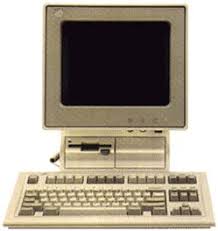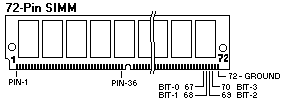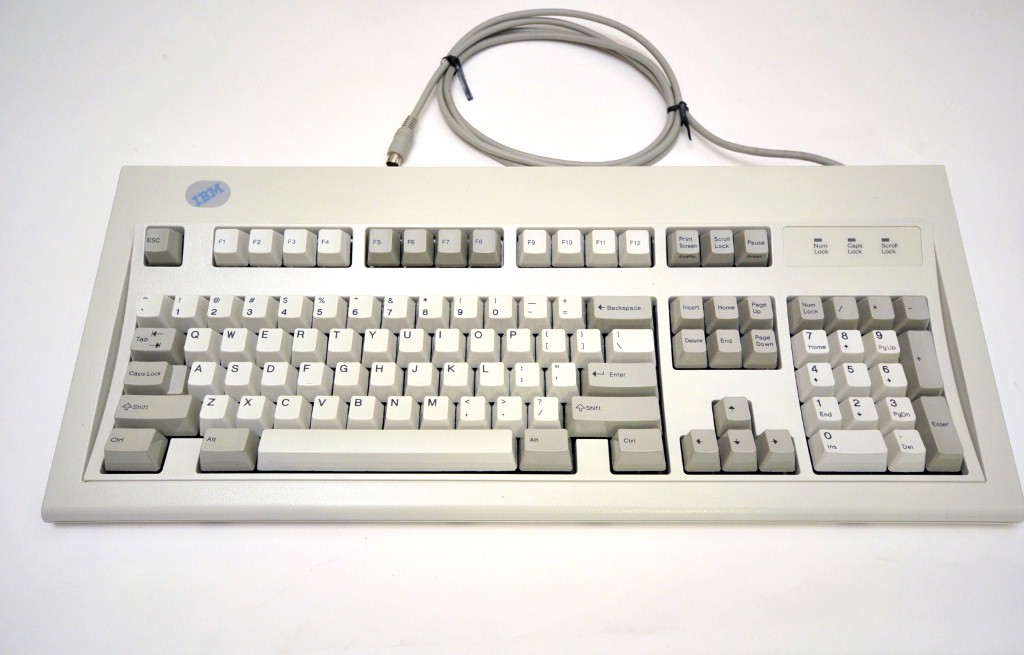IBM PS/2 Model 25
Introduction
Following the first series of PS/2 machines launched in April 1987 which consisted of the Model 30, 50, 60 and 80, IBM added the Model 25 (IBM Part 8525) to the list. The Model 25 was aimed at replacing the IBM PC, and was the lowest-spec'd model in the line-up. It came with 512 KB of memory and ran an Intel 8086 at 8 MHz. Unlike other PS/2s, the Model 25 was an "all-in-one" unit - the monitor and system unit are a single piece.
Typically the Model 25 was sold with either one or two 3.5" 720 KB floppy drives. An optional 20 MB hard disk could be purchased, a Seagate ST-506, which took the place of one of the floppy drives.
Like the Model 30, the Model 25 employed MCGA graphics, which offered CGA graphics resolutions (320 x 200) but in 256 colours, plus a monochrome 640 x 480 mode. Several display options were available, including a 12" monochrome, or 14", 16" or 19" colour monitor.
Since this was considered a 'budget' model, the Model 25, like the 30, contained only ISA expansion slots instead of the IBM's new MCA (Micro Channel Architecture) which was saved for the more premium models.
Subsequent Model 25 versions were released to support newer hardware. In 1990, IBM launched the Model 25-286. As the name implies, the 25-286 ran an Intel 80286 microprocessor and came with either 512 KB or 1 MB RAM depending on the model purchased - this was expandable up to 4 MB. It supported VGA graphics and got a high-density 1.44 MB floppy drive. The top-range model also came with a 30 MB hard disk. It was discontinued on 17th November 1992.
In early 1992, the Model 25SX arrived which had an Intel 80386SX-16, 1 MB or 4MB RAM (upgradable to 16 MB), a high-density 3.5" 1.44 MB floppy drive, on-board IDE and Super VGA graphics. This model was sold solely to the educational market. Sub-models K01 and L02 came with a second VGA OUT port, plus Remote Initial Program Load (RIPL) as a standard feature. K01 supported an Ethernet network card whilst L01 supported a Token Ring network card. Whilst you could purchase a hard disk for the 25SX, no submodels were released with a hard disk fitted as standard.
Sub-Models
Model 25:
IBM 8525-001 (or "Type 1") - 8086 CPU, 12" Monochrome ("Paper White") monitor, space-saving keyboard - $1,350 MSRP.
IBM 8525-G01 (or "Type 1") - 8086 CPU, 12" Monochrome ("Paper White") monitor, enhanced keyboard - $1,395 MSRP.
IBM 8525-004 (or "Type 4") - 8086 CPU, 12" Colour monitor, space-saving keyboard - $1,695 MSRP.
IBM 8525-G04 (or "Type 4") - 8086 CPU, 12" Colour monitor, enhanced keyboard - $1,740 MSRP.
Model 25-286:
IBM 8525-006 - 80286-10 CPU, 512 KB RAM, 12" VGA colour monitor, space-saving keyboard - $2,295 MSRP.
IBM 8525-G06 - 80286-10 CPU, 512 KB RAM, 12" VGA colour monitor, enhanced keyboard - $2,340 MSRP.
IBM 8525-036 - 80286-10 CPU, 1 MB RAM, 30 MB hard disk, 12" VGA colour monitor, space-saving keyboard - $2,995 MSRP.
IBM 8525-G36 - 80286-10 CPU, 1 MB RAM, 30 MB hard disk, 12" VGA colour monitor, enhanced keyboard - $3,040 MSRP.
Model 25SX:
IBM 8525-K00 - 80386SX-16, 1 MB RAM, 12" VGA colour monitor - $2,082 MSRP.
IBM 8525-K01 - 80386SX-16, 4 MB RAM, 12" VGA colour monitor, Ethernet adapter - $2,832 MSRP.
IBM 8525-L02 - 80386SX-16, 4 MB RAM, 12" VGA colour monitor, Token Ring adapter - $3,165 MSRP.
Optional Accessories
IBM offered a wide range of optional accessories for the Model 25. These can be viewed in the initial announcement text: Model 25, Model 25-286, or Model 25SX.
Compatibility
Hardware - EXPANSION
The Model 25 came with two 8-bit ISA expansion slots.
The Model 25-286 came with two 16-bit ISA expansion slots.
The Model 25SX came with three 16-bit ISA slots - on the same riser card a fourth 16-bit ISA slot was on the "flip" side of the board, and was designed specifically for the network card (Ethernet or Token Ring), since a port on the back of the system lined up with the network port of IBM's network cards.
Hardware - BIOS
The PS/2 line actually had two BIOSes. One, called ABIOS, or Advanced BIOS, was designed with the new MCA technology in mind. The second, called CBIOS, or Compatible BIOS, was in place to ensure the system would be fully "backward" compatible with IBM PC-DOS. The ROM was 64 KB in size, split between two 32 KB ROM chips held in sockets at U19 and U20 on the motherboard.
If the CMOS battery is dead on your 25SX, you will see error code 161 and 163 on power-up. In this state, the system will not be able to read 1.44 MB disks as the system defaults to 720 KB only. Get a Dallas 12887+ replacement CMOS RAM battery and fit it (desoldering/soldering obviously required).
Hardware - MEMORY
Model 25 and 25-286:
The PS/2 line unfortunately do not use standard 30-pin memory. Instead they use a proprietary "IBM" type RAM which have a different pinout than regular 30-pin SIMMs. The originally supplied memory modules had silver cans on top of the chips. When replacing your memory, they don't have to be the metal can type ones - any SIMM with the right [IBM] pinout should work. According to the original IBM specification sheet, the RAM is: DRAM (MMK) 100-150ns w. parity.
Model 25SX:
Memory on the PS/2 Model 25SX was 1 MB as standard, but had a memory slot for upgrade purposes. These took 72-pin SIMMs with ECC (parity) but needed to be a specific type that has 4 additional 'presence detection' pins.

These 4 pins (67-70) on the memory module tell the system board if a module is installed, and if so, its size and speed. There are ways to fool the system into believing a special IBM module is there by jumping the correct configuration of these 4 pins to GND pin 72 (each configuration differs based on the size of memory and its speed). Visit here or here for a good write-up of these configurations.
Hardware - POWER SUPPLY
There are no Molex power connectors from the supplied 70W IBM PS/2 power supply. Instead all powered devices (floppy disk drives, hard drives, etc) use a proprietary fitting. The IBM PS/2 Model 30 PSU does not work as a drop-in replacement for the Model 25s - the power connectors going into the motherboard are different.
HARDWARE - KEYBOARD
The Model 25s shipped either either with the IBM "space-saving" keyboard or the IBM "enhanced" keyboard.
The space-saving one was a Model M (1391472), and had 84 keys. It had no separate numeric keypad.
The IBM "Enhanced" keyboard was a Model M (1391406), which had 101 keys.

Hardware - FLOPPY DRIVES
The high-density floppy drive wasn't even an optional purchase from IBM for the first Model 25. When IBM designed the floppy interface for the PS/2 line they moved away from their previous IBM PC/XT/AT interface, and chose to create a new proprietary one. This included a single power and data cable (instead of the separate 4-pin power and 20-pin data cable), and they also changed the drive logic. PS/2 floppy drives were mostly manufactured by Alps Electric or Mitsubishi. Sony and YE-Data ones are out there, but are less common.
Reliability of PS/2 floppy drives is probably the weakest link in the whole computer. The drives had no dust shutter so could easily get contaminated inside. Furthermore, electrolytic capacitors can leak (especially after 25 years!) and cause corrosion of the logic board on the drive.
It is now known that the Model 25's floppy drive interface does support high-density disks (3.5" 1.44 MB). Not all disk drives will work though. Sony-manufactured drives are more likely than the others to work correctly. Other drives will only be "seen" as low-density.
Hardware - HARD DRIVES
As mentioned, the power supply on PS/2 models doesn't provide you with any Molex power connectors for drives - all drives (floppy and hard) use a proprietary single cable which supplies power and data direct from/to the motherboard.
HARDWARE - VIDEO
The Model 25 came with IBM's MCGA (Multi-color Graphics Adapter) which pre-dated VGA. It supported the following modes:
40x25 text mode in 16 colours (8x16 character box)
80x25 text mode in 16 colours (8x16 character box)
320x200 in 256 colours, 70 Hz refresh rate - all points addressable
640x480 in 2 colours, 60 Hz refresh rate - all points addressable
Total palette of 262,144 colours.
Compatible with analog displays *only*.
Monochrome display sums colours to 64 gray shades.
Due to the Model 25's MCGA limitations later VGA games may not run properly - it is possible to install a VGA ISA card. The Model 25 uses the same internal connector and breaks it out to a 'standard' 15-pin DSUB, that can be used as a reference for the pinout. All 286 PS/2 systems came with VGA - only the 8-bit models (Model 25 and 30) came with MCGA.
HARDWARE - CPU
The CPU in the original PS/2 Model 25 can be upgraded with an NEC V30 for a *significant* performance boost and ability to run some 286 instruction sets, although the V30 doesn't reports itself in software as a 286, so don't expect 286 performance.
The Model 25SX came with either an 80386SX-16 or 80386SX-20 underclocked to 16 MHz, presumably depending upon availability of the 16 MHz CPUs. There are also rumours of 80386SX-20 CPUs running at the full 20 MHz as well.
HARDWARE - MOTHERBOARD ICs
Below are the main ICs identified on the motherboard of each of the Model 25s.
| Model 25 | Model 25-286 | Model 25SX |
|---|---|---|
| U? - Intel 8086-2 CPU at 8MHz U5 - Inmos IMSG171P Video RAMDAC U6 - Hitachi HM53461P U7 - Hitachi HM53461P U8 - Intel P8253-5 U9 - 72X8203 U10 - ROM BIOS (also marked U20, don't know why) U11 - Seiko Epson SLA64030J2L U13 - ROM BIOS, also marked as U17, no idea why U14 - OKI/IBM 72X8206 U15 - Seiko Epson SLA6330J1C U16 - NEC D4164C-10 U17 - See U13 U18 - NEC D765AC-2 (FDC?) U19 - Siemens 8237A U27 - National Semiconductor NS8250AV U33 - NEC D4164C-10 U34 - NEC D4164C-10 U35 - NEC D4164C-10 U38 - Sony CXK5864BM-12L U44 - OKI M3764A-15 ZM1 - OKI M3764A-15 (no mistake--it is not a "Uxx" marked chip!) ZM3 - Earphone Connector (the "EP" above is not marked on the planar, I added it) Y1 - 14.31818MHz OSC for software clock (this system has no CMOS hardware clock!) Y2 - 25.175MHz OSC for what? Y3 - 48.0MHz - divided by 6 for CPU clock? F1 - Keyboard Fuse |
F1 KB/Mouse fuse J1 Pointing-device connector J2 Keyboard connector J3 Parallel port J4 Display connector J5 Serial port J6 Bus-adapter connector J7 Power-supply connector J9 Memory packs J10 Optional memory packs J11 Hard-disk drive connector J12 Diskette-drive connector J13 Password-override connector J14 Power-supply connector J15 Earphone? SP1 Speaker ZM1 Math coprocessor connector ZM2 VLSI VL82C100 ZM3 VLSI VL82C102A ZM4 VL82C103A ZM5 VLSI VL82C104 ZM6 VLSI VL82C101B ZM9 VLSI VL16C451 ZM14 27F4094 DISKGA ZM18 15F6864 VGA ZM19 NEC D765BC ZM23 IMSG171P-35 ZM33 8042 ZM35 Clock module connector ZM36 80286-10 ZM46 EPROM ZM47-54 64Kx4 Y1 14.318 MHz osc Y2 25.175 MHz osc Y3 20.322 MHz osc Y4 20 MHz osc Y5 48.00000 MHz osc |
U2 - Intel i386SX-16 or 20 (Underclocked to 16MHz in most, some have a 16MHz part here, see below) U5 - 80387SX-16 Socket U8 - VLSI VL82C304 U9 - VLSI VL82C305-FC U10 - Intel i8042 Keyboard Controller (Interesting package--never seen that kind before!) U16 - OKI 92F1173 U25 - Intel 82077AA FDC U26 - IBM BIOS P/N 87F4794 U33 - Memory Chip solder pads (populated on non "K" models) U34 - Memory Chip Hitachi HM514900JP8 U32 - Memory Chip solder pads (populated on non "K" models) U42 - IBM SVGA 84F7985 (same as on the 512K SVGA/A, 40SX and 57sxx planars) U43 - Toshiba TC511665BZ-80 VRAM ZIP U44 - Toshiba TC511665BZ-80 VRAM ZIP U45 - Inmos IMSG171P Video RAMDAC U48 - Memory chip solder pads (populated on non "K" models) U49 - Memory chip solder pads (populated on non "K" models) U51 - Toshiba TC511665BZ-80 VRAM ZIP U54 - Toshiba TC511665BZ-80 VRAM ZIP J1 - Possible speaker output? Jumpered on 1-2. J2 - Power On Password Clear J10 - IDE J11 - Floppy Disk Drive Cable J12 - Power Connector J13 - Power Connector J14 - 4 pin Molex male connector for hard disk drive power J16 - Unknown Function Y1 - 32.768 kHz Hardware RTC OSC Y2 - 14.31818 Software RTC OSC Y3 - 25.175MHz OSC (For i82077AA?) Y4 - 28.322MHz OSC (For what?) OS1 - 32.0000MHz OSC for i386SX (it's underclocked, maybe one could use a 40MHz OSC?) OS2 - 48.0000MHz OSC (for what?) OS3 - 41.5390MHz OSC (for what?) |
Software
The PS/2 Model 25 came with a "Starter" disk, which was a system disk that booted into IBM PC-DOS. It had a set of utilities on it for configuring the PC as well as diagnostics. See the Downloads section for more details. Note that the Starter Disk for other models of PS/2 are not interchangeable - use the one that is specifically designed for your PS/2 Model.
The Model 25-286 was designed for DOS 3.3 or 4.0, or OS/2 Extended Edition 1.0 or 1.2.
The Model 25SX came supplied with IBM PC DOS 5.0.
Physical
System Unit: 360 (W) x 410 (D) x 400 (H) mm
Weight: ? kg (3.8 lbs)